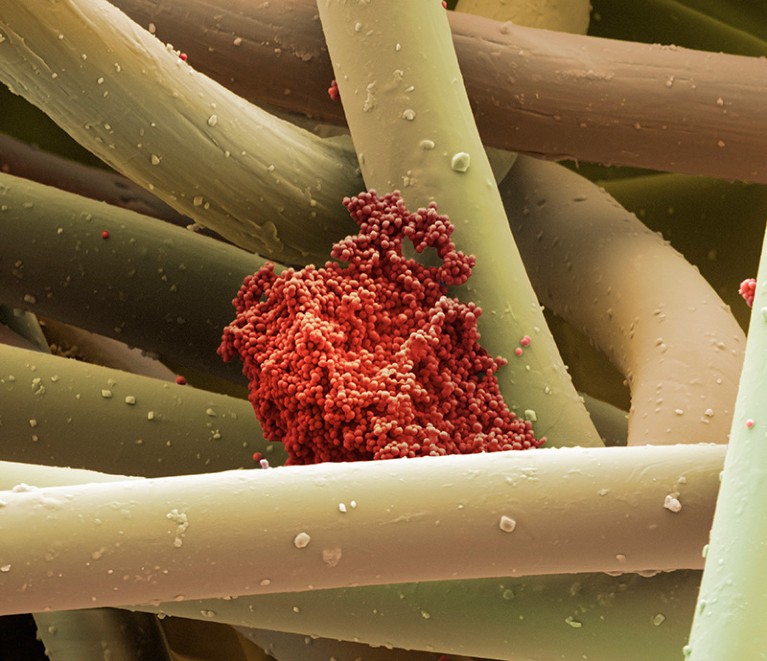
Staphylococcus aureus on the microscopic fibres of a wound dressing.Credit: Science Photo Library
The need to find new antibiotics is pressing, but many scientists and policy makers are tackling antimicrobial resistance from other angles. Nature Index takes a look at three methods in more detail.
A plasma wash
Plasma-activated water, enriched with chemically unstable versions of oxygen and nitrogen — also known as radical and reactive species — is being considered as potential new disinfectant. “If bacteria are overwhelmed with radicals then they end up dying,” says Katharina Richter, a biomedical researcher at the University of Adelaide in Australia.
Richter and her colleagues are studying how fast plasma-activated water can clear wounds infected with methicillin-resistant Staphylococcus aureus (MRSA) compared with wounds left untreated. They’re also comparing the technique against administering an antibiotic through an intravenous drip. She says the initial results, which are yet to be published, are encouraging. “The treatment improved the wound and cleared the infection faster than without treatment,” she says. It wasn’t as effective as treatment with antibiotics, but Richter says the experimental design could be to blame. “We compared it with IV antibiotics and that isn’t comparing apples with apples. It would be fairer to compare it to antibiotics given topically. Our next study will have better controls.”
Metallic marvel
Bacteria, although single cells in nature, do get together and help each other to evade drugs and antiseptics. One way they do that is by forming biofilms — groups of bacteria living in a slimy milieu of their own making. Biofilms protect the individual cells residing within; it’s thought that roughly 80% of chronic human infections are caused by biofilms.
Nature Index 2022 Biomedical sciences
The metallic element, gallium, interrupts bacteria’s uptake of iron, which eventually starves the microbes of nutrition. Because of this, gallium-laced drugs are one avenue being explored as a way to undermine biofilms. Scientists at the University of Manchester, UK, have found that gallium compounds can reduce the growth of bacteria by as much as 87% (J. M. Baker et al. Life Sci. 305, 120794; 2022). This work builds on the results of researchers at Shanghai Jiao Tong University in China showing that gallium can effectively dissolve the structure of MRSA biofilms, allowing the bacteria to be killed with one-tenth of the usual dose of an antibiotic (W. Xia et al. ACS Infect. Dis. 7, 2565–2582; 2021). Research is now focusing on how best to deliver the gallium and in what doses.
Molecular visas
An antibiotic should have three key characteristics: solubility; the capacity to readily bind to bacteria; and the ability to penetrate cell membranes. That makes designing a new antibiotic a tough task.
Instead of creating completely new antibiotics, therefore, some researchers are sifting through large digital libraries to predict which existing compounds might already have what it takes. “There are established methods for assessing the first two characteristics in a matter of minutes, but permeation is the missing piece of the puzzle,” says Javad Deylami, a computational chemist at the biotech start-up BIOptimize in Singapore.
That means that scientists are often assessing compounds that would theoretically be good at killing bacteria, but fall short at the first hurdle of getting inside the bacteria, says Deylami. “It’s like they reach a border but don’t have a visa to pass.”
Deylami has constructed a computerized version of the outer cell membrane of a bacterium on which he conducts simulations, testing the ability of molecules to penetrate the membranes. His model determines the forces affecting a would-be drug as it passes or fails, allowing Deylami to calculate the permeability of compounds.
Running known molecular structures through the program, Deylami’s team is able to learn, with the help of artificial intelligence, what qualities a compound needs to increase its permeability. That knowledge should help them to hunt through massive libraries to find existing drugs that have these properties.

 Biomedical breakthroughs come of age
Biomedical breakthroughs come of age
 How gene therapy is emerging from its ‘dark age’
How gene therapy is emerging from its ‘dark age’
 The ebb and flow of the biomedical sciences in the pandemic era
The ebb and flow of the biomedical sciences in the pandemic era
 Tackle antimicrobial resistance with a pandemic-style mobilization
Tackle antimicrobial resistance with a pandemic-style mobilization
 Organoids open fresh paths to biomedical advances
Organoids open fresh paths to biomedical advances
 Challenging the high-dose paradigm for cancer drugs
Challenging the high-dose paradigm for cancer drugs








